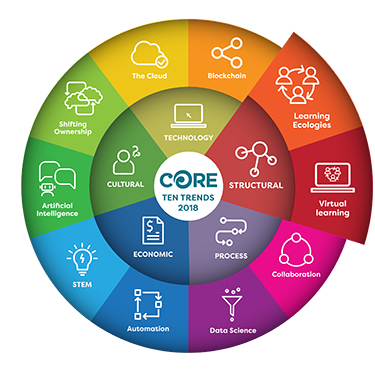Virtual Learning

What’s it about?
Simply put, virtual learning is access to education that doesn’t require attendance at a physical place called school or other learning institution. It utilises the affordances of online technologies to connect learners with the source of instruction and with each other, and can occur at any time, any place, and at any pace.
In their 2008 book, Disrupting Class: How Disrupting Innovation Will Change the Way the World Learns, Harvard business theorists Clayton Christensen, Michael Horn, and Curtis Johnson envision a future in which education is highly customised to each student’s learning style, relying heavily on special software and virtual courses. Their prediction that one-quarter of all high school courses (in the US) would be online by 2016 and one-half by 2019 was ambitious to say the least. However, the steady growth in virtual learning in the US and other countries seems to support the basic principle: by empowering students and parents, individualised virtual learning is one promising path to incrementally improving modern education.
Virtual learning courses offered on-site at regular schools — referred to in some contexts as “blended education” — are also an increasingly popular option, allowing learners to access specialist knowledge from wherever they are and whenever they need. The blended learning approach can also include the notion of ‘flipped learning’, where a student is engaged in the research and investigation elements of an inquiry outside of school, while using the opportunity in-school to work collaboratively in teams on projects.
A 2016 report from the World Economic Forum titled, “Is online learning the future of education?”, highlights this trend, focusing on the issue of access as a key driver for adoption of virtual learning, and recognising the ‘borderless’ nature of schools and education generally in our changing world.
What’s driving this?
There are three key drivers behind the escalation of virtual learning in our schools and education system:
- Advances in technology. The reach and reliability of online services is now at a point where the dream of ubiquitous access is becoming a reality. In addition, the interactive and immersive dimensions of emerging online learning environments provide a richer and more engaging experience for learners.
- Emphasis on learner agency and choice. The issues of an ever-widening curriculum, together with understandings about how learners learn, are increasingly challenging the structures of our traditional, face-to-face schooling system. Virtual learning approaches enable learners to exercise greater choice over what they learn, how they learn, when they learn, and who they learn with and from.
- Supply and demand issues. Possibly the greatest challenge for education systems around the world is the crisis that exists because there are not being enough teachers available to fill subject-specific roles in traditional schools. While we require a subject matter expert to be physically present in every school to work with classes of students, this is unlikely to be resolved. Additionally, many areas of the world are facing levels of demand for education that exceed their ability to build schools and provide teachers in the traditional way. This is the case even in New Zealand, in places like Auckland!
What examples of this can I see?
While virtual education may not be the answer to all these issues, it is certainly going to be a part of the answer, incorporated into and alongside other forms of educational provision.
In New Zealand, like other parts of the world, students who are unable or unwilling to attend a conventional school have been catered for by distance education providers such as Te Aho o Te Kura Pounamu (The Correspondence School). Increasingly, virtual learning approaches are being used here instead of the traditional print-based materials and occasional email exchange.
The Virtual Learning Network (VLN) Community has been active in New Zealand for over a decade, and has its roots going back into the early 1990s with the CASAtech, TOSItech and KAWM programmes, designed to cater for learners in rural and remote schools by enabling teachers in one school to work with cohorts of students from a variety of other schools.
Both these groups are likely to be taking advantage of the recently created provisions in the Education Act Update that legislates for the development of COOLs (Communities of Online Learning), opening opportunities for a wider range of providers and allowing learners greater choice regarding the subjects they want to take, and greater professional opportunities for teachers.
Further examples of the expansion of virtual learning can be seen in the widespread adoption of providers such as the Khan academy, that provides ‘mini-lessons’ in video format that can be viewed and reviewed by learners.
In the New Zealand context, LEARNZ has been offering virtual fieldtrips for students for nearly two decades, using online technologies to take students into experiences they would otherwise not be able to.
Consortia of universities such as Coursera and Udacity are now offering courses online – many of which are free or requiring payment only if you wish to have your work recognised for a credential.
On a more pragmatic level, collaborative online tools such as Google Docs and Office365 provide learners and teachers with opportunities for engagement in learning beyond the classroom.